Introduction
A few days after the release of the blog post Gotta Catch ‘Em All: Frida & jailbreak detection, someone on reddit - r/ReverseEngineering caught my attention on a cheating app for the Android version of PokemonGO:

So here it is!
PGSharp belongs to the family of PokemonGO’s cheating app that is not (yet) banned by Niantic. This cheat provides an enhanced game experience with interesting functionalities such as:
- GPS Spoofing
- Quick Catch
- Pokemon Feed
- Nearby Radar
- …
Last but not least, PGSharp runs on regular devices, rooted or not.
This cheat made my weekends for the last 4 months and, from a technical point of view, it was worth it. As will be discussed through this blog post, PGSharp uses several interesting tricks.
Note
The content of this blog post is based on PGSharp 1.33.0 which is related to the following APKs:
This blog post is quite long but the different parts are more or less independents, so feel free to jump on them depending on your interests:
You can also check the slides to get an overview of the content:
Enjoy!
Code Protection
PokemonGO is a target of choice for reverse engineers and some critical functionalities are protected by a commercial solution.
It is worth mentioning that only a subset of the game is obfuscated. For instance, the “Java” part of the
game is absolutely not protected, such as we have the original class and method names.
The Unity part is “compiled” into libil2cpp.so but we can recover some metadata with Perfare/Il2CppDumper.
All the obfuscation is focused on libNianticLabsPlugin.so (c.f. Gotta Catch ‘Em All: Frida & jailbreak detection),
and since only this part of the game is heavily obfuscated, it gives a hint about where the critical functionalities are.
On the other hand, PGSharp uses different layers of obfuscation to prevent its analysis. First of all, it uses O-LLVM to obfuscate the native code that includes, at least, control-flow flattening and string encryption. Nevertheless, the obfuscation is relatively weak against emulation and static analysis1.
Lua VM
Some obfuscation techniques are based on transforming the original code through a VM (like VMProtect). It adds another layer to reverse, as we need to understand the VM architecture before being able to understand the original semantic of the code.
But what about using an interpreted language (like Python) and obfuscate its VM or its interpreter with O-LLVM?
This is what PGSharp does with Lua. Some parts of the cheat are written in Lua whose VM has been modified to:
- Fake the version: try to make believe
Lua 5.1while it’sLua 5.3 - Add new opcodes (
OP_RUN,OP_GETDOWNVAL,OP_OLDTABLE, andOP_XXOR) to break decompilation and common Lua tools.
The native library that implements the cheat functionalities and that contains the Lua VM being stripped, one of the challenges lies in recognizing the Lua C API among the library’s functions2. For instance, here is a basic block of a native function that uses the Lua API:
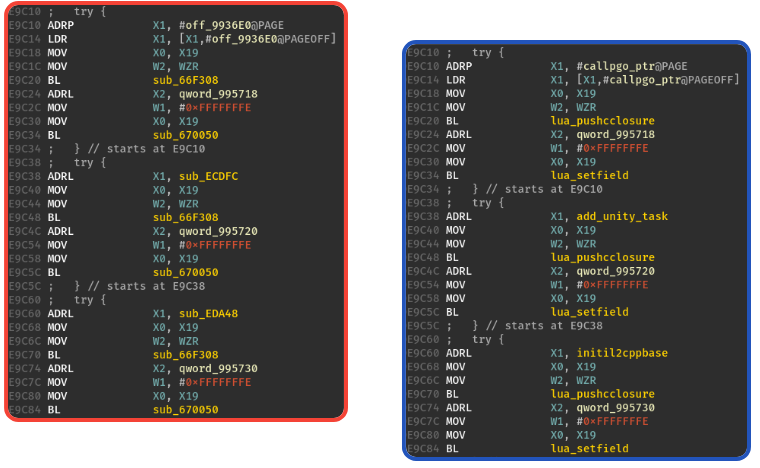
Among all the Lua C functions, some of them are worth identifying to ease reverse engineering:
luaL_loadbuffer“Load a buffer as a Lua chunk.”.
Basically, it loads a Lua bytecode from a buffer given in parameter. This Lua bytecode is the result of the compilation of the original script with luac. By hooking this function, we can recover the following files:
- base64.luac
- class.luac
- global.luac
- init.luac
- json.luac - from https://github.com/rxi/json.lua
- location.luac
- md5.luac - from https://github.com/kikito/md5.lua
- pgo.luac
- pgodump.luac
- plugin.luac
- reflect.luac
The orange files are utilities, while the green ones contain cheat mechanisms.
luaD_precall- Function that is involved when calling a C native function or a pure Lua function. Since its prototype is (lua_State *L, StkId func, int nresults), it can help to dynamically identify which function is called:
0x6776a8 luaD_precall('gamehelper') 0x6776a8 luaD_precall('@./app/arm64-v8a/luac/global.lua:0 - sub_71733ea5d0') { 0x694d90 luaD_precall('@./app/arm64-v8a/luac/global.lua:246 - sub_71733f7b50') { 0x6776a8 luaD_precall('@./app/arm64-v8a/luac/location.lua:38 - sub_717346d650') {lua_pushcclosurePushes a new C closure onto the stack.
This function is particularly interesting to recover native C functions linked to Lua function:
0x0e9cc0: lua_pushcclosure('initil2cppmethods') 0x0e9cd4: lua_setfield(-2, 'initil2cppmethods', 'func_0xedaa0') ... 0x0e9d10: lua_pushcclosure('nar') 0x0e9d24: lua_setfield(-2, 'nar', 'func_0xeddbc') ... 0x0ea020: lua_pushcclosure('ipf') 0x0ea034: lua_setfield(-2, 'ipf', 'func_0x1318b0')lua_pushstring“Pushes the zero-terminated string pointed to by s onto the stack.”
This function enables to dynamically recover strings that might not be present in the native code or somehow encoded:
0x0ebdfc: lua_pushstring('https://tens.pgsharp.com/v1/scc-2-[...]/') 0x0ebe28: lua_pushstring('me.uw.hela.pref') 0x0c56ac: lua_pushstring('AIza[...]XhM4') 0x0e15b4: lua_pushstring('token=[Redacted]')
To dynamically understand the behavior of the Lua VM, we can compile the Frida Gum SDK along with Lua v5.3.
It enables to hook Lua functions with Frida and to leverage the compiled Lua v5.3 to inspect the parameters:
extern "C" {
#include "lua.h"
#include "ldo.h"
#include "ldebug.h"
}
gum_interceptor_attach(listener_->interceptor,
luaD_precall_addr, listener_ luaD_precall_addr);
void native_listener_on_enter(GumInvocationListener *listener, GumInvocationContext* ic) {
auto* L = reinterpret_cast<lua_State*>(ic->cpu_context->x[0]);
auto func = reinterpret_cast<StkId>(ic->cpu_context->x[1]);
auto narg = static_cast<int>(ic->cpu_context->x[2]);
if (ttype(func) != LUA_TLCL) {
return log("sub_{:x}", ptr);
}
Proto *p = clLvalue(func)->p;
return log("{}:{:d} - sub_{:x}", getstr(p->source), p->linedefined, ptr);
}
Java Obfuscation
Contrary to the PokemonGO’s Java layer, PGSharp protects its Java code with Proguard and the strings are xored with the hardcoded key:
vqGqQWCVnDRrNXTR
This key seems to not change across the different versions of PGSharp and the encoded strings look like this:
public void q() {
String a = GL.a(r3.a("FAQgLiQlLw=="), (String) null);
if (a != null) {
JSONObject jSONObject = new JSONObject();
Context context = GL.c;
jSONObject.put(r3.a("Agg3FA=="), r3.a("Axg="));
jSONObject.put(r3.a("Axgj"), UI.g(context));
jSONObject.put(r3.a("BQUmBTQ="), this.s);
jSONObject.put(r3.a("BQEoHjc+LTE="), ((Boolean) ...);
jSONObject.put(r3.a("BAUr"), UI.f());
jSONObject.put(r3.a("Gh8g"), Locale.getDefault().getDisplayLanguage());
jSONObject.put(r3.a("FxMu"), UI.a());
jSONObject.put(r3.a("FBA1"), LayoutInflater$Factory2o.i.e(context));
jSONObject.put(r3.a("Gx4j"), Build.MODEL);
String str = Build.VERSION.RELEASE;
}
}
The string encoding routine being easy to reverse, we can create a Jadx plugin that automatically decodes these strings:
[...]
passes.add(new SimplifyVisitor());
passes.add(new PGSharpString()); // Automatically decode the strings
passes.add(new CheckRegions());
[...]
It results in this kind of output:
public void q() {
String a = GL.a("bug_url", (String) null);
if (a != null) {
JSONObject jSONObject = new JSONObject();
Context context = GL.c;
jSONObject.put("type", "ui");
jSONObject.put("uid", UI.g(context));
jSONObject.put("state", this.s);
jSONObject.put("spoofing", ((Boolean) PL.a("hlspoofing")).booleanValue());
jSONObject.put("rtl", UI.f());
jSONObject.put("lng", Locale.getDefault().getDisplayLanguage());
jSONObject.put("abi", UI.a());
jSONObject.put("bar", LayoutInflater$Factory2o.i.e(context));
jSONObject.put("mod", Build.MODEL);
String str = Build.VERSION.RELEASE;
}
}
You can find the whole Jadx plugin on Github: PGSharpStrings.java
Cheat Mechanisms
One disruptive feature of PGSharp is that it does not require a rooted device. Until recently,
most of the PokemonGO cheating apps required a jailbroken or a rooted device which raises a barrier
for people who are not familiar with rooting.
But wait, how hell they do that?
The structure of the PGSharp APK is very close to the genuine PokemonGO application, which leads identifying which parts of the game have been tampered with.
A naive comparison (cf. zip_diff.py) raises mismatches on the following files:
| File | Size in PGSharp | Size in PGO | Delta |
|---|---|---|---|
| classes.dex | 9057844 | 8953000 | +1.17% |
| classes2.dex | 7131864 | 7107296 | +0.34% |
| lib/arm64-v8a/libmain.so | 21278480 | 6424 | +331134% |
| META-INF/MANIFEST.MF | 351045 | 355533 | -1.26% |
The high level of similarity between the two applications, associated with a different signature confirms that PGSharp repackaged the original application.
DEX Files Comparison
To figure out which parts of the DEX files have been modified, we can use LIEF (yes, LIEF can read the DEX format). Basically, the idea is to check which method(s) has a bytecode whose size is different from the real PokemonGO application:
import zipfile
import lief
with zipfile.ZipFile(CHEAT_FILE) as zip_file:
with zip_file.open(target) as f:
hela_dex = f.read()
with zipfile.ZipFile(ORIG_FILE) as zip_file:
with zip_file.open(target) as f:
pgo_dex = f.read()
hela_dex = lief.DEX.parse(list(hela_dex))
pgo_dex = lief.DEX.parse(list(pgo_dex))
hela = {f"{m.cls.pretty_name}.{m.name}.{m.prototype!s}": len(m.bytecode) \
for m in hela_dex.methods}
pgo = {f"{m.cls.pretty_name}.{m.name}.{m.prototype!s}": len(m.bytecode) \
for m in pgo_dex.methods}
for k, size_hela in hela.items():
size_pgo = pgo[k]
if size_pgo != size_hela:
print(f"Mismatch: {k}")
By running this script on classes.dex, we don’t find any difference.
Actually, the PGSharp authors tried to prevent diffing by changing the line number attribute of the DEX classes.
If we try to diff the two applications from the output of apktool or Jadx, we get a lot of noise as the line number is
used in the output. On the other hand, the size bytecode for this kind of repackaging is suitable3.
Running the same script on classes2.dex raises the following mismatches:
holoholo.libholoholo.unity.UnityMainActivity.onActivityResultholoholo.nativelib.Library.<clinit>
In UnityMainActivity.onActivityResult, they changed this piece of code:
public void onActivityResult(int i, int i2, Intent intent) {
UnityCallbackInfo unityCallbackInfo = this.activityCallbacks.get(Integer.valueOf(i));
if (unityCallbackInfo != null) {
UnityPlayer.UnitySendMessage(unityCallbackInfo.mGameObjectName,
unityCallbackInfo.mMethodName,
String.valueOf(i2));
} else {
Client.handleActivityResult(i, intent);
}
}
into:
public void onActivityResult(int i, int i2, Intent intent) {
UnityCallbackInfo unityCallbackInfo = this.activityCallbacks.get(Integer.valueOf(i));
if (unityCallbackInfo != null) {
String mGameObjectName = unityCallbackInfo.mGameObjectName;
UnityPlayer.UnitySendMessage(mGameObjectName, unityCallbackInfo.mMethodName, "HL.PL".equals(mGameObjectName) ? intent == null ? "" : intent.getData().toString() : String.valueOf(i2));
return;
}
Client.handleActivityResult(i, intent);
}
While in the static constructor of the Library class, they force the loading of libmain.so:
static {
System.loadLibrary("main");
System.loadLibrary("holoholo");
}
Now, let’s look at libmain.so
libmain.so
Compared to the original PokemonGO APK, libmain.so in PGSharp is substantially larger. Moreover, the ELF metadata leaks the original file name of the file:
$ readelf -d libmain.so
...
0x000000000000000e (SONAME) Library soname: [libhela.so]
...
During the analysis of PGSharp, we find references to Hela
in different places, like the package name
of the dynamically-loaded APK: me.underworld.helaplugin.
Originally, the purpose of this library is to initialize some parts of the Unity engine but PGSharp uses it to load its main payload.
In the cheating app, libmain.so is responsible for:
- Initializing the Lua VM
- Implementing Lua native C functions
- Implementing JNI functions
- Calling the Lua scripts
libmain.so exposes JNI_OnLoad which is used as an entrypoint
to perform the actions listed above.
The JNI functions don’t have a meaningful name but thanks to their callsites, we can figure out their purpose:
| Name | Description | Rename |
|---|---|---|
| NRL | Trigger Lua function from Java | NativeRunLua |
| NSMTC | Trigger PGSharp Action | - |
| NOHRB | OkHtttp callback | NativeOkHttpResponseByte |
| NOHR | OkHtttp callback | NativeOkHttpResponse |
| NOHF | OkHtttp callback | NativeOkHttpFailure |
| NIOS | Google Signing? | - |
| NIOR | Seems not used | - |
| NOT | Perform periodic actions on Lua threads | NativeOnTimer |
| NIPE | Related to PokemonGO Plus | - |
| NIOF | Seems to do nothing relevant | - |
Similarly, for the Lua C closures, we get the following table:
| Name | Description | Rename |
|---|---|---|
| callpgo | Trigger Lua function from Java | - |
| add_unity_task | Trigger PGSharp Action | - |
| initil2cppbase | OkHtttp callback | - |
| initil2cpphooks | OkHtttp callback | - |
| initil2cppmethods | OkHtttp callback | - |
| newjbytearray | Create a Java bytearray from Lua | - |
| nar | - | nativeAttestResponse |
| ngak | - | nativeGetApiKey |
| findclass | Find a Java class from Lua | - |
| gettid | Get Thread ID | - |
| logi | Log info (empty) | - |
| logv | Log verbose (empty) | - |
| init_plugin_natives | Init Java layer (JNI + nUSlwbRIjReLowOP) | - |
| uf_whitelist | empty | - |
| uf_forbid | empty | - |
| uf_redirect | empty | - |
| fkinitjni | Lua wrapper4 | FakeInitJNI |
| fknalp | Lua wrapper4 | FakeNativeAddLocationProvider |
| fkngsu | Lua wrapper4 | FakeNativeGpsStatusUpdate |
| fknlu | Lua wrapper4 | FakeNativeLocationUpdate |
| getPoisFromCache | Related to the autowalk feature | - |
| Action | Event Task |
|---|---|
| 1 | plg.float.click |
| 2 | plg.float.remove |
| 3 | plg.map.tp |
| 4 | plg.setspeed |
| 5 | plg.randomwalk |
| 6 | plg.enablespoof |
| 7 | plg.joystart |
| 8 | plg.joystop |
| 9 | plg.entergame |
| 10 | plg.pause |
But wait, since they repackage the application they have to re-sign the application and you won’t tell me that PokemonGO does have signature checks?
And this is where the fun begins!
The functionalities of PGSharp heavily rely on hooking but not the hooking you might think of …
Signature Bypass
As it is detailed in the next section, libmain.so dynamically loads another APK. Within
this APK, and more precisely in the class androidx.appcompat.app.AppCompatDelegateImpl5, we can notice this method:
/* renamed from: g */
public static void proxifySignatureCheck(Context context) {
String packageName = context.getPackageName();
Class<?> aThreadCls = Class.forName("android.app.ActivityThread");
Object mCurrentActivityThread = aThreadCls.getDeclaredMethod("currentActivityThread", new Class[0]).invoke(null, new Object[0]);
Field sPackageManager = aThreadCls.getDeclaredField("sPackageManager");
sPackageManager.setAccessible(true);
Object pm = sPackageManager.get(mCurrentActivityThread);
Class<?> IPackageManager = Class.forName("android.content.pm.IPackageManager");
SignatureMock mock = new SignatureMock(pm, "30820 [ ... ] aa001f55", packageName)
Object newProxyInstance = Proxy.newProxyInstance(IPackageManager.getClassLoader(),
new Class[]{IPackageManager}, mock);
sPackageManager.set(mCurrentActivityThread, newProxyInstance);
PackageManager packageManager = context.getPackageManager();
Field mPM = packageManager.getClass().getDeclaredField("mPM");
mPM.setAccessible(true);
mPM.set(packageManager, newProxyInstance);
}
This code leverages the Java hooking API, java.lang.reflect.Proxy, to proxify the Android PackageManager ¯\_(ツ)_/¯.
The mocked PackageManager looks like this:
public SignatureMock(Object pm, String originalSignature, String packageName) {
this.mPackageManager = pm;
this.mOriginalSignature = originalSignature;
this.mPackageName = packageName;
}
@Override // java.lang.reflect.InvocationHandler
public Object invoke(Object obj, Method inMeth, Object[] args) {
PackageInfo packageInfo;
SigningInfo signingInfo;
// Hook getPackageInfo
if ("getPackageInfo".equals(inMeth.getName())) {
String pkgName = (String) args[0];
int flags = ((Integer) args[1]).intValue();
// Handle both
// GET_SIGNATURES (0x00000040) - Deprecated in API 28
// GET_SIGNING_CERTIFICATES (0x08000000)
if ((flags & PackageManager.GET_SIGNATURES) != 0 &&
this.mPackageName.equals(pkgName)) {
PackageInfo fakePkgInfo = (PackageInfo) inMeth.invoke(this.mPackageManager, args);
// Fake the signature
fakePkgInfo.signatures[0] = new Signature(this.mOriginalSignature);
return fakePkgInfo;
} else if (Build.VERSION.SDK_INT >= 28 &&
(flags & GET_SIGNING_CERTIFICATES) != 0 &&
this.mPackageName.equals(pkgName) &&
(signingInfo = (packageInfo = (PackageInfo) method.invoke(this.mPackageManager, args)).signingInfo) != null) {
Field FieldSigningDetails = signingInfo.getClass().getDeclaredField("mSigningDetails");
FieldSigningDetails.setAccessible(true);
Object mSigningDetails = FieldSigningD.get(packageInfo);
Signature[] fakeSigArray = {new Signature(this.mOriginalSignature)};
Field FieldSignatures = mSigningDetails.getClass().getDeclaredField("signatures");
FieldSignatures.setAccessible(true);
FieldSignatures.set(FieldSigningDetails, fakeSigArray);
return packageInfo;
}
}
return inMeth.invoke(this.mPackageManager, args);
}
In doing so, when PokemonGO accesses the PackageManager, it gets a mocked version of the PackageManager
that is controlled by PGSharp.
PGSharp changes the behavior of getPackageInfo() to return the real PokemonGO signature instead of its own.
The following figure outlines the process:
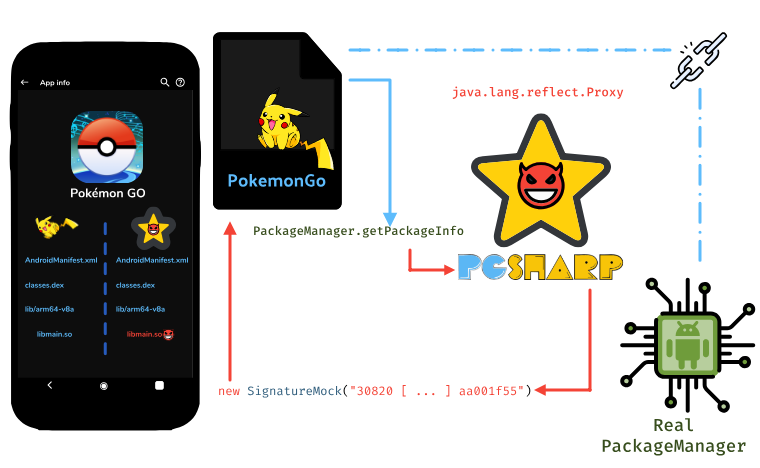
Dynamic APK Loading
In the Lua script plugin.lua, PGSharp defines an init function that performs the following
actions:
local filesdir = (ref.call_method)(runtime.app, "getFilesDir", "()Ljava/io/File;")
local filesdirpath = (ref.call_method)(filesdir, "getAbsolutePath", "()Ljava/lang/String;")
u_plugin_path = (gh.ipf)(loadjstring(filesdirpath))
ipf is a function that takes the output of cxt.getFilesDir().getAbsolutePath() as parameter,
in other words, the path of the files directory of PokemonGO: /data/data/com.nianticlabs.pokemongo/files,
and returns a u_plugin_path as a Lua string.
If we look for ipf in the Lua scripts, we don’t find any implementation. Actually, this
function is referenced in the gamehelper() function of libmain.so where it is
linked as follows:
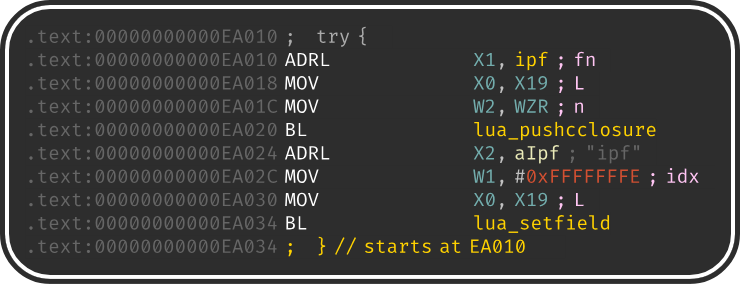
So ipf is a native Lua C function registered with lua_pushcclosure.
Once we identified the location of ipf, the logic of the function can be summarized with this pseudo code:
// file_dir: /data/user/0/com.nianticlabs.pokemongo/files
void ipf(lua_State *L) {
// std::string ctor @0xA4F00
std::string outpath = lua_tostring(L, -1);
// std::string::append @0xD868C
outpath.append("/");
outpath.append("LZZqoKpt.plg");
FILE* fout = fopen(outpath.c_str(), "wb");
// @0x634424
extract_apk_file(FILE* fout) {
for (chunk : chunks) {
decode(chunk, 0x2710);
fwrite(chunk, 0x2710, 1, fout);
}
}
fclose(fout);
lua_pushlstring(L, outpath.c_str(), outpath.size());
}
void inline_decode(uint8_t* data, size_t size) {
for (size_t i = 0; i < size; ++i) {
// Byte decoding
data[i] = (0xb3 & ~data[i]) | (data[i] & 0x4c)
}
}
/data partition,
one can also pull the file from the device (this file is not removed when PGSharp stops running).The written file, LZZqoKpt.plg, is actually an APK that is loaded with PathClassLoader in the Lua script:
u_classloader = (ref.new_instance)("dalvik/system/PathClassLoader",
"(Ljava/lang/String;Ljava/lang/String;Ljava/lang/ClassLoader;)V",
(env.NewStringUTF)(u_plugin_path),
nativeLibraryDir,
gh.pgo_classloader);
u_plugin_cls = findclass("me/underworld/helaplugin/PL", u_classloader)
u_global_cls = findclass("me/underworld/helaplugin/GL", u_classloader)
u_runnable_cls = findclass("me/underworld/helaplugin/HR", u_classloader)
u_global_cls = (env.NewGlobalRef)(u_global_cls)
u_plugin_cls = (env.NewGlobalRef)(u_plugin_cls)
u_classloader = (env.NewGlobalRef)(u_classloader)
u_runnable_cls = (env.NewGlobalRef)(u_runnable_cls)
u_runnable_init_mid = (env.GetMethodID)(u_runnable_cls, "<init>", "(ILjava/lang/Object;)V")
u_geturl_mid = (env.GetStaticMethodID)(u_plugin_cls, "GU", "(Ljava/lang/String;Ljava/lang/String;)I")
u_postString_mid = (env.GetStaticMethodID)(u_plugin_cls, "vtEdUZmWQYAgtGWs", "(Ljava/lang/String;Ljava/lang/String;Ljava/lang/String;)I")
u_postBytes_mid = (env.GetStaticMethodID)(u_plugin_cls, "BbTwaTXurePBxTDt", "(Ljava/lang/String;[BLjava/lang/String;)I")
u_onLuaMessage_mid = (env.GetStaticMethodID)(u_plugin_cls, "tFAxNZCNHOXBTYGM", "(ILjava/lang/Object;Ljava/lang/Object;)Ljava/lang/Object;")
u_global_updatelocation_mid = (env.GetStaticMethodID)(u_global_cls, "ul", "(DD)V")
u_global_savelocation_mid = (env.GetStaticMethodID)(u_global_cls, "sl", "()V")
(gh.init_plugin_natives)(u_classloader)
(ref.call_static_method)(u_plugin_cls,
"rDymrMuxPIlIESFe", "(Landroid/app/Application;Ljava/lang/String;I)V",
runtime.app, (env.NewStringUTF)(u_plugin_path), runtime.log_level)
local cls = (gh.findclass)("me.underworld.helaplugin.HLVM", u_classloader)
local hlviewmanagerref = (ref.call_static_method)(cls, "getInstance", "()Lme/underworld/helaplugin/HLVM;")
u_sm_mid = (env.GetMethodID)(cls, "SM", "(Ljava/lang/String;I)V")
u_setviewshow_mid = (env.GetMethodID)(cls, "SVC", "(Ljava/lang/String;Z)V")
u_hlviewmanager = (env.NewGlobalRef)(hlviewmanagerref)
plugin.classloader = u_classloader
GPS Spoofing
Since PokemonGO heavily relies on the user’s location, the must-have feature for the PokemonGO cheat engines is to be able to spoof the GPS location.
The genuine PokemonGO application manages the user location through the Java class NianticLocationManager,
which exposes three natives functions:
- nativeAddLocationProviders(Context ctx)
- nativeGpsStatusUpdate(int i, SatelliteInfo[] info)
- nativeLocationUpdate(String providerName, Location location, …)
nativeAddLocationProviders aims at instantiating the different location providers as Java object:
- FusedLocationProvider
- GnssLocationProvider
- GpsLocationProvider
- NetworkLocationProvider
while nativeLocationUpdate and nativeGpsStatusUpdate are a kind of callbacks triggered when there is
a new user location to consider.
The implementation of nativeLocationUpdate checks natively if the location object given in the second parameter
is mocked (cf. isMock() or isFromMockProvider()).
Actually PGSharp hooks two of these three native methods:
- nativeAddLocationProviders(Context ctx)
- nativeGpsStatusUpdate(int i, SatelliteInfo[] info)
- nativeLocationUpdate(String provider, Location location, …)
By hooking nativeLocationUpdate, they can modify the value of the Location parameter to change
the real location.
“You assert that PGSharp hooks
nativeLocationUpdateandnativeAddLocationProvidersinlibNianticLabsPlugin.so, but this library is protected by a commercial obfuscator which has anti-hooks features. How do they hook these functions?”
And this is where the fun reaches another level 🚀
JNIEnv Proxifier
I would assume that nativeLocationUpdate and nativeAddLocationProviders are critical
enough to be protected against hooking. It turns out that PGSharp embeds a hooking framework to hook
Unity functions, but they don’t use it on these functions.
The authors of PGSharp found a subtle trick to circumvent the anti-hook protection.
nativeLocationUpdate and nativeAddLocationProviders are JNI functions
that are dynamically registered by Java_com_nianticlabs_nia_unity_UnityUtil_nativeInit:
Java_com_nianticlabs_nia_unity_UnityUtil_nativeInit(env, ...) {
env->RegisterNatives(...);
}
The env parameter refers to the JNIEnv structure which is an array of function pointers:
struct JNINativeInterface {
...
jclass (*GetObjectClass)(JNIEnv*, jobject);
jboolean (*IsInstanceOf)(JNIEnv*, jobject, jclass);
jmethodID (*GetMethodID)(JNIEnv*, jclass, const char*, const char*);
...
}
The values of these pointers are defined by the implementation of the “JVM” which is, for Android, the Android RunTime (ART).
For instance, FindClass is actually a pointer
to art::{CheckJNI, JNIImpl}::FindClass located in art/runtime/jni/{jni_internal, check_jni}.cc:
static jclass FindClass(JNIEnv* env, const char* name) {
Runtime* runtime = Runtime::Current();
ClassLinker* class_linker = runtime->GetClassLinker();
std::string descriptor(NormalizeJniClassDescriptor(name));
ScopedObjectAccess soa(env);
ObjPtr<mirror::Class> c = nullptr;
if (runtime->IsStarted()) {
StackHandleScope<1> hs(soa.Self());
Handle<mirror::ClassLoader> class_loader(hs.NewHandle(GetClassLoader<kEnableIndexIds>(soa)));
c = class_linker->FindClass(soa.Self(), descriptor.c_str(), class_loader);
} else {
c = class_linker->FindSystemClass(soa.Self(), descriptor.c_str());
}
return soa.AddLocalReference<jclass>(c);
}
If we hook Java_com_nianticlabs_nia_unity_UnityUtil_nativeInit from the genuine PokemonGO,
and we check where the pointers of the JNIEnv structure point to, we get this kind of output:
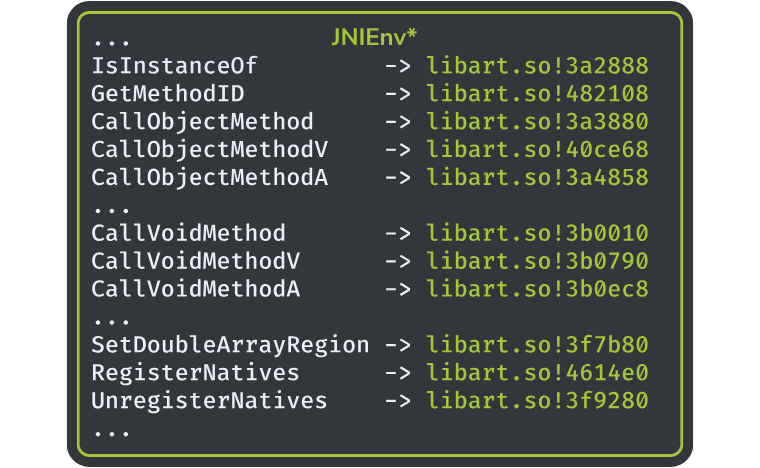
This output is consistent with what we said about the JVM and the runtime ART. If we do the same check on PGSharp, we get this result:
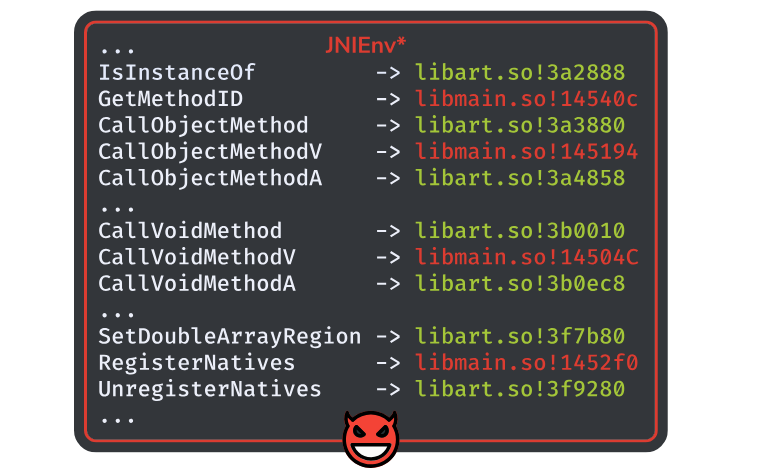
As we can see, some pointers have been relocated to point in libmain.so:
| JNI Function | Offset in libmain.so (v1.33.0) |
|---|---|
| GetMethodID | 0x14540c |
| CallObjectMethodV | 0x145194 |
| CallVoidMethodV | 0x145040 |
| RegisterNatives | 0x1452f0 |
It means that when libNianticLabsPlugin.so is calling one of the functions listed above,
the execution is forwarded to libmain.so instead of libart.so.
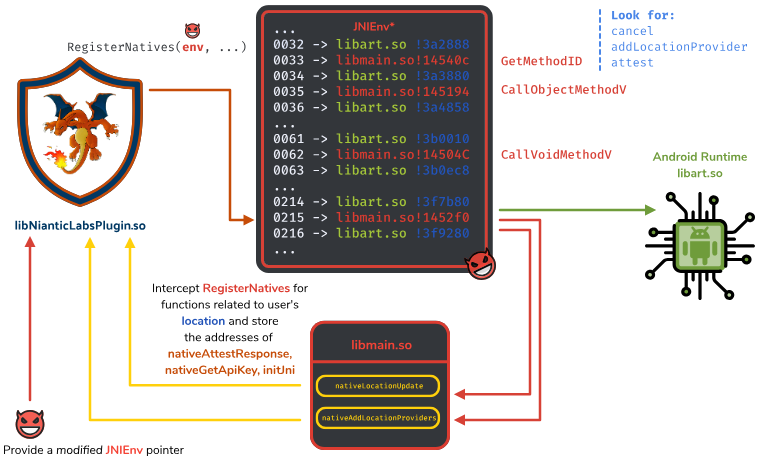
PGSharp proxifies these functions for the following purposes:
GetMethodID
To monitor:
- SafetyNetService.attest
- SafetyNetService.cancel
- NianticLocationManager.addLocationProvider
CallVoidMethodV
To monitor the parameters of:
- SafetyNetService.attest (to intercept the nonce)
- SafetyNetService.cancel
RegisterNatives
Proxified to get, and potentially change, the effective location of the
libNianticLabsPlugin.so JNI functions:
- nativeAttestResponse
- nativeGetApiKey
- nativeAddLocationProviders
- nativeLocationUpdate
- initJni
- nativeInjectEvent
- nativeUnitySendMessage
- nativeRender
- nativeMuteMasterAudio
By managing the function JNIEnv::RegisterNatives, they are able to change the value of JNINativeMethod.fnPtr,
such as when PokemonGO calls nativeLocationUpdate, it actually calls a function managed by PGSharp.
It results that JNI functions used by libNianticLabsPlugin.so have been redefined:
| JNI Function | Location |
|---|---|
| NianticLocationManager.nativeAddLocationProviders | libmain.so!ea868 |
| NianticLocationManager.nativeGpsStatusUpdate | libNianticLabsPlugin.so!bc508 |
| NianticLocationManager.nativeLocationUpdate | libmain.so!ea8bc |
| NLog.nativeDispatchLogMessage | libNianticLabsPlugin.so!4beaa0 |
| NetworkConnectivity.nativeNotifyNetworkStateChanged | libNianticLabsPlugin.so!6f8118 |
| NianticTrustManager.nativeCheckClientTrusted | libNianticLabsPlugin.so!9b9cc |
| NianticTrustManager.nativeCheckServerTrusted | libNianticLabsPlugin.so!73b42c |
| NianticTrustManager.nativeGetAcceptedIssuers | libNianticLabsPlugin.so!6dc5c8 |
| WebsocketController.nativeOnDidClose | libNianticLabsPlugin.so!6fcabc |
| WebsocketController.nativeOnDidFail | libNianticLabsPlugin.so!4a0d0c |
| WebsocketController.nativeOnDidOpen | libNianticLabsPlugin.so!5922b0 |
| WebsocketController.nativeOnDidReceiveData | libNianticLabsPlugin.so!742fa8 |
| SafetyNetService.nativeAttestResponse | libNianticLabsPlugin.so!5ea1b8 |
| SafetyNetService.nativeGetApiKey | libNianticLabsPlugin.so!6bc60 |
| NianticSensorManager.nativeCompassUpdate | libNianticLabsPlugin.so!4b9bc0 |
| NianticSensorManager.nativeSensorUpdate | libNianticLabsPlugin.so!177c44 |
Unity Hooks
In addition to GPS spoofing, PGSharp provides other functionalities such as, Pokemon feed, skip evolve animation …
In the genuine PokemonGO application, these functionalities are implemented in the Unity layer
that is compiled into libil2cpp.so.
To perform these functionalities, PGSharp hooks (hooking like Frida) some of these Unity functions.
They tried to hide6 the underlying hooking framework used to perform these hooks, unfortunately they missed to remove important strings:
$ strings ./libmain.so|grep -i -E "\w\+\.cc"
E:/work/code/Hela/app/src/main/cpp/Dobby/source/InterceptRouting/Routing/FunctionInlineReplace/FunctionInlineReplaceExport.cc
E:/work/code/Hela/app/src/main/cpp/Dobby/source/TrampolineBridge/Trampoline/arm64/trampoline-arm64.cc
E:/work/code/Hela/app/src/main/cpp/Dobby/source/MemoryAllocator/MemoryArena.cc
E:/work/code/Hela/app/src/main/cpp/Dobby/source/InstructionRelocation/arm64/ARM64InstructionRelocation.cc
E:/work/code/Hela/app/src/main/cpp/Dobby/source/UserMode/PlatformUtil/Linux/ProcessRuntimeUtility.cc
E:/work/code/Hela/app/src/main/cpp/Dobby/source/UserMode/UnifiedInterface/platform-posix.cc
So the hooking framework is Dobby:
Unity hooks start, in the script init.lua of PGSharp where they wait for the loading of libil2cpp.so7:
set_event_handler("pgo.il2ready",
function(il2base)
runtime.il2base = il2base;
(gh.initil2cppmethods)();
(gh.initil2cpphooks)();
end
)
initil2cppmethods() aims at resolving the address of PokemonGO Unity functions needed to perform cheating actions,
while initil2cpphooks() dobby-hooks some Unity functions to change their behaviour.
In the version 1.33 of PGSharp, they hook 207 functions
of libil2cpp.so and we will take one of them to detail the internal mechanisms:
UnityEngine.Application$$OpenURL
First of all, if we look at the symbols or the strings of libil2cpp.so, we don’t find meaningful information that could
help to figure out the original purpose of the Unity functions. In fact, the Unity metadata are embedded
in global-metadata.dat, and to recover the bindings between this file
and libil2cpp.so, we can use Perfare/Il2CppDumper.
They compute the absolute of a Unity function by adding the offset provided by global-metadata.dat
to the base address of libil2cpp.so. Here is an example UnityEngine.Application$$OpenURL:
MOV W13, 0x4bfeea0 ; Offset of the function (thanks to global-metadata.dat)
ADRP X14, #Application_OpenURL
ADD X13, X8, X13 ; Add the libil2cpp.so base address
STR X13, [X14, #Application_OpenURL] ; Store the absolute address in libmain.so
The function associated with initil2cpphooks() is quite large as shown in the figure below:

Actually, the function is large but easily understandable statically8. The right-hand side of the figure is actually
the catch { ... } handlers of the exceptions, while the left-hand side that goes down, initializes
C++ objects. In this area of the CFG, we find the same pattern that repeats all the way down:
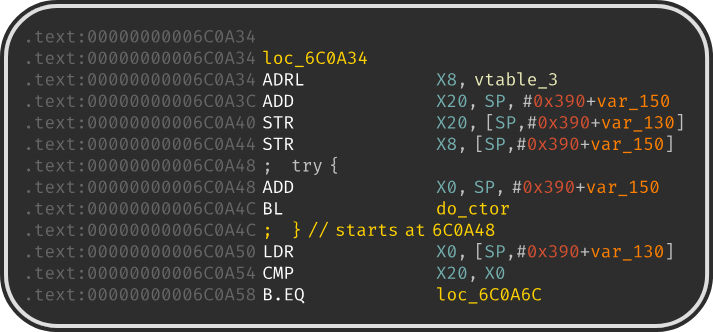
From what we can see, it initializes a C++ object (on the stack) and the first instructions setup the VTable. We can find the relevant function in the last entry of the VTable that contains the hooking logic:
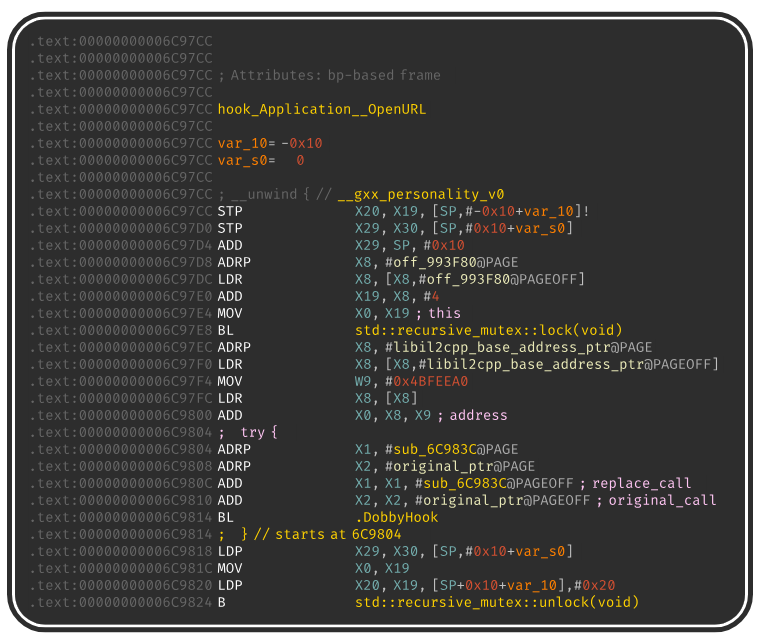
From this code, we can see that they perform the resolution of the absolute address of
UnityEngine.Application$$OpenURL. Also, thanks to the prototype of DobbyHook() we can
quickly understand that the new behavior of OpenURL is located in the function sub_6C983C:
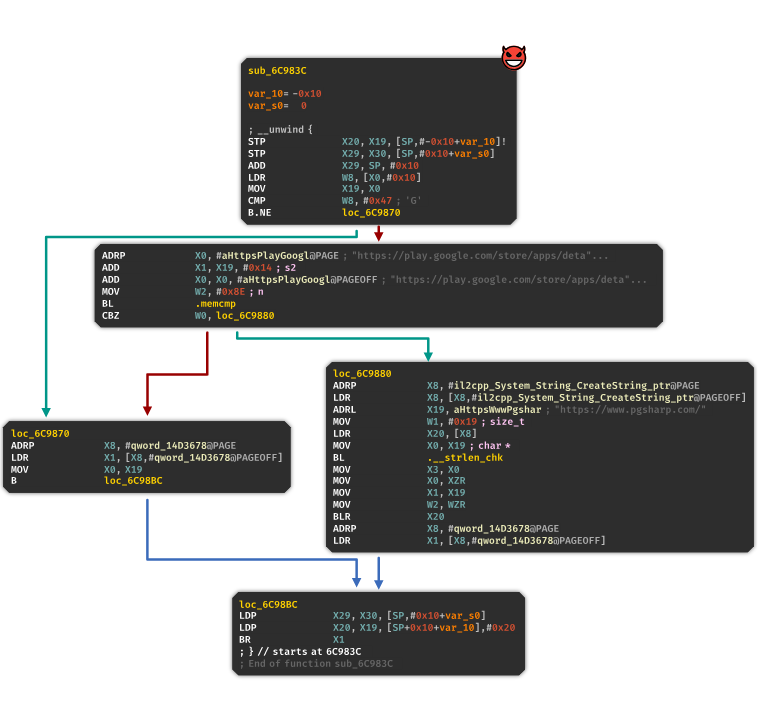
In this hook, they check if PokemonGO is opening its Google Play URL and redirect the user to the PGSharp home page.
Network Communications and Encryption
The cheating application communicates with its servers through the TLS/HTTP protocol and adds another layer
of encryption on the top of TLS. To encrypt the HTTP payload, they use AES in the CBC mode.
We can identify the AES algorithm thanks to clear S-BOX present in the .rodata section.
It seems that they use different keys, depending on the endpoint the application targets but we can retrieve them by hooking the AES key schedule function. It results that we can decrypt the communication between the application and the PGSharp servers9.
Here are examples of endpoints and the data sent by PGSharp:
- POST
hazelnuts- Action: Handshake
- Request:
{ "bid": "com.nianticlabs.pokemongo", "clt": "pgs", "host": "Samsung A40", "lv": -1, "nonce": "", "nonce_key": "", "pgver": "0.221.0", "uid": "00000000-00000000-[...]", "ver": "1.33.0" } - Response:
{ "err": 0, "shiny": ["List of shiny"], "hotplaces": [ { "name": "🇧🇷 Consolacao, São Paulo, Brazil", "lat": -23.5512, "lng": -46.6584 }, ] }
- POST
Cw8dfkXpW7mq2i- Action:
PGS_ACTIONS.GETPLAYER - Request:
{ "bid": "com.nianticlabs.pokemongo", "clt": "pgs", "host": "Samsung A40", "lv": 4, "nonce": "", "nonce_key": "", "pgver": "0.221.0", "player": { "ban": 0, "captured": 3, "encountered": 5, "kmwalked": 10.50, "outage": 0, "pid": "[redacted]", "serverlo": 0, "susp": 0, "suspa": 0, "visits": 1, "warn": 0, "warna": 0, "warndt": 623234511000000000, "warntm": 0 }, "uid": "00000000-00000000-[...]", "ver": "1.33.0" }
- Action:
- POST
SSZgBPn6Ixq2ZK- Action:
PGS_ACTIONS.GETREPORTABLE - Request:
{ "bid": "com.nianticlabs.pokemongo", "clt": "pgs", "host": "Samsung A40", "lv": 4, "nonce": "", "nonce_key": "", "pgver": "0.221.0", "raid": [ { "battle": 1634490000000, "campaignId": "", "complete": false, "costume": 12233, "dex": 326, "eligible": false, "end": 1634490000000, "exclusive": false, "form": 0, "free": false, "gender": 1, "hidden": false, "lat": 0.1234, "lng": 5.6789, "lv": 3, "mov1": 163, "mov2": 90, "schedule": false, "seed": 5000000, "spawn": 1634400000000, "team": 1, "web": 0, "wec": 3 }, ], "uid": "00000000-00000000-[...]", "ver": "1.33.0" }
- Action:
- POST
/pga/keycode/v-q2mgqcyji/- Action: Activate PGSharp with a premium key
- Request:
{ "ver": "1.33.0", "gi": 1, "key": "AVerySecretKey", "host": "Samsung A40", "clt": "pgs", "ua": "Samsung A40/11/[redacted]/arm64-v8a/[redacted]/unknow/unknown/English", "uid": "00000000-00000000-[...]" }
SafetyNet
In addition to standard code obfuscation, PokemonGO uses SafetyNet as an attestation mechanism.
Similarly to the GPS management, we find a (non-obfuscated) Java layer implemented in the class
SafetyNetService. This class exposes two native functions:
- String nativeGetApiKey()
- void nativeAttestResponse(byte[] nonce, String jwtResult)
The implementation of these two functions is obfuscated within libNianticLabsPlugin.so.
The first function is used to get the Google SafetyNet API key (AIzaSyCh8l[...]_eOTXhM4) while the second one,
is involved in the validation of the SafetyNet attestation.
Thanks to the JNIEnv proxy on GetMethodID and CallVoidMethodV,
PGSharp is able to monitor the calls to SafetyNetService.attest(bytes[] nonce). When this function is called,
PGSharp intercepts the nonce and forward the request to its servers:
https://tens.pgsharp.com/v1/scc-2-eg[...]4/
The request is performed through a http POST, whose data are encrypted with AES. The clear payload has the following layout:
{
"n": "Cy[...]",
"type": "attest",
"ver": "<PGSharp Version>",
"k": "i3[...]",
"clt": "pgs",
"data": {
"k": "AIzaSyCh8l[...]_eOTXhM4 <- From nativeGetApiKey",
"n": "<nonce>"
}
}
On success, the server responses with an AES-encrypted payload which has the following layout:
{"result":"suc: <JWT SafetyNet Attestation>"}
The JWT SafetyNet value is then forwarded by PGSharp to nativeAttestResponse() with the original nonce.
At some point, this JWT attestation is sent to Niantic’s servers (on the endpoint plfe/112/rpc2)
wrapped by a Protobuf structure.
To understand how they “bypass” SafetyNet, let’s look at the JWT payload:
{
"nonce": "<nonce>",
"timestampMs": 1636265656,
"apkPackageName": "com.nianticlabs.pokemongo",
"apkDigestSha256": "ioYmlh5mk5EhMUH/DsaG1jrhUoQJDK/2IvK61eiAXJE=",
"ctsProfileMatch": true,
"apkCertificateDigestSha256": [
"lEvaRm6vZL4ck4ltXI6aRUoHyNj8vEre7vs1RbM16Xk="
],
"basicIntegrity": true,
"evaluationType": "BASIC"
}
First of all, the JWT is correctly signed by Google SafetyNet’s key and the apkCertificateDigestSha256
matches the signature of the real PokemonGO application.
But …
The value of apkDigestSha256 does not match the checksum of the genuine PokemonGO application 😕
Here are my hypothesis:
The server https://tens.pgsharp.com/v1/scc-2-eg/... forwards the SafetyNet request to
a real application that runs on a real device. This application would have been created by PGSharp authors
to really run SafetyNet and to get a valid attestation signed with a valid Google key.
The fake application would have been created with com.nianticlabs.pokemongo as package name
and would implement signature mocking, as discussed in the first part.
If they would have managed to break SafetyNet, the apkDigestSha256 value would have been consistent.
The JWT attestation is forwarded to Niantic so they might check the consistency of apkDigestSha256
but they might only focus on the signature (which can be faked) and not this value …
When PGSharp avoids PokemonGO pitfalls
As discussed in the section Signature Bypass, PGSharp tricks the Android PackageManager to mock the signature of the application.
It turns out that PGSharp is also concerned about app repackaging. As they provide premium features, they don’t want to be cheated …
In the function associated with PGS_ACTIONS.INITPOST they perform a device fingerprint
whose one of these elements is the APK’s signature. But instead of using the Android PackageManager to
retrieve the signature, they use DimaKoz/stunning-signature
to compute the MD5 digest of the signature.
Final Words
When I started to look at this cheating app, I did not expect to find such nice tricks and challenges. The PGSharp’s authors know the sneaky tricks to hinder reverse engineering. Unfortunately, O-LLVM is relatively weak in this context compared to the commercial obfuscator used by Niantic.
On the other hand, the design of PokemonGO is such that all the reverse engineering difficulties lie in one single module that can be treated in black-box once we identified the API. In particular, the un-obfuscated Java layer helps a lot to identify these API.
Regarding the signature bypass, at first, I thought it would be easy to prevent by checking the integrity
of the .apk and/or the native libraries. But, there are some points that need to be taken into account:
APK Integrity Check
Naively, we might want to compute a checksum of the APK or re-compute the signature (as it’s done by PGSharp).
But in fact, since a few years, Google tries to push
developers to use app bundle such as an application is no longer a single .apk but a split .apk.
While this feature optimizes the device’s data partition size, it complicates the verification
of the signature since it would require to deal with different files and different checksum.
It’s not infeasible, but it complicates its implementation in the APK build & development pipeline.
Native Library Integrity Check
I guess that libNianticLabsPlugin.so implements checksum on its own library as it is
a sensitive part of the application. Regarding the other libraries, some of them are owned
by Niantic (like libholoholo.so) and others come from third-parties (like libmain.so). Depending on
how they are integrated, the checksum of these external libraries might not be easy to automatically
compute while releasing a new version of PokemonGO. These third-party libraries are,
most of the time, not copy-pasted by the developers but automatically bundled when compiling the
application. Therefore, computing their checksums might require tweaking the build process
in a non-easy way.
On the top of that, Niantic releases a new version of its games on a monthly basis. It means that these checks need to be automated in CI/CD pipeline which might not be trivial to do.
It was a funny and very interesting journey, for those who want to dig a bit more in PGSharp, I pushed some materials and documents on Github. In particular, you can find the symbol list of libmain.so based on reverse engineering.
Acknowledgments
This analysis has been independently done in my spare time while being at Quarkslab and UL, my current employer.
Annexes
Third-Party
Here is the (non exhaustive) list of the open-source projects used by PGSharp:
List of the Unity Functions used by PGSharp
object__Invoke
String_CreateString1
String_CreateString3
ulong_object___get_Item
ulong_object___ContainsKey
ulong_object___TryGetValue
Application_OpenURL
Application_set_targetFrameRate
Quaternion_Angle
PlayerPrefs_TrySetInt
PlayerPrefs_TrySetFloat
PlayerPrefs_TrySetSetString
PlayerPrefs_SetInt
PlayerPrefs_GetInt
PlayerPrefs_SetFloat
PlayerPrefs_GetFloat
PlayerPrefs_SetString
PlayerPrefs_GetStringNoDefault
PlayerPrefs_HasKey
PlayerPrefs_DeleteKey
Component_get_gameObject
Transform_get_rotation
Animator_get_speed
Animator_set_speed
Animator_SetTriggerID
Animator_Update
Promise__ctor
Promise_Complete
MapMath_MetersBetween
NL_NLAny_object_
NL_NLFirst_object_
InputField_ActivateInputField
InputField_DeactivateInputField
Text_set_text
Text_set_fontSize
DiContainer_InjectExplicitInternal
Schedule_WaitOn_c__AnonStorey0____m__0
GameState_EnterState
GameState_ExitState
RpcBindings_Send
RpcManager_DispatchCallbacks
Animator_SetTriggerID
RpcManager_DispatchCallbacks
AuthService_get_CachedCredentialsExist
AuthService_Logout
DeviceServiceExtensions_IsUsable
GameMasterData_IsPokemonWeatherBoosted
Animator_SetTriggerID
AuthService_get_CachedCredentialsExist
AuthService_Logout
PgpApi_UpdateNotifications
ARPlusEncounterValuesProto__ctor
ARPlusEncounterValuesProto__cctor
PlayerService_GetPlayerDayBucket
PlayerService_get_PlayerStats
PlayerService_get_CurrentPokeball
PlayerService_get_CurrentLinkedLogins
AuthService_get_CachedCredentialsExist
PlayerService_get_PokemonBag
PlayerService_GetPlayerProfile
PlayerService_set_CurrentPokeball
PlayerService_get_BagIsFull
PlayerService_GetCandyCountForPokemon
StateToken_Complete
TimeUtil_ServerNowMs
RequestGymDetailsById_onSucceed
RequestGymDetailsById_onError
PlayerPrefs_SetInt
BluetoothUtil_get_IsBluetoothEnabled
PgpGuiController_ClickIcon
PgpGuiService_SetSfidaIconVisible
PgpGuiService_EnableSfidaIcon
ulong_object___get_Item
PgpService_get_IsSessionActive
PgpService_GetCurrentNotificationType
ItemBagImpl_GetItemCount
PokemonBagImpl_GetPokemon
ulong_object___get_Item
PgpApi_UpdateNotifications
Animator_set_speed
StateToken_Complete
VersionCheckService_CheckVersion
ulong_object___TryGetValue
QuestMapPokemon_get_Pokemon
QuestService_BeginQuestEncounterWithOut
EulaGuiController_PressAccept
StarterMapPokemon_get_Pokemon
OpenRemoteGym_gymOpner
OpenRemoteGym_onSucceed
BluetoothUtil_get_IsBluetoothEnabled
QuestService_BeginQuestEncounterWithOut
RaidState_ExitGymWithRaidDetails
AccountChoiceState_ClickNewPlayer
AccountChoiceState_ClickExistingPlayer
LoginAgeGateState_SubmitSelections
LoginChoiceState_ClickPtc
LoginChoiceState_ClickGoogle
LoginGuiController_ClickSubmit
PtcLoginState_SubmitLogin
I18n_PokemonMoveName
I18n_SetUpLanguageTable
I18n_PokemonNameTemporaryEvolution
I18n_Text
I18n_PokemonName
FriendsGuiState_StartOpenGiftFlow
FriendsGuiState_StartSendGiftFlow
FriendsRpcService_RemoveGiftbox
GiftingRpcService_SendGift
GiftingRpcService_OpenGift
StickerService_GetStickerInventory
CombatDirector_Initialize
MapPokestop_get_PoiId
MapPokestop_get_ActiveIncidentType
MapPokestop_get_Location
EncounterParkCameraController_PlayIntro
RunPokemonCaptured_onDitto
EncounterInteractionState_RunAway
MapMath_MetersBetween
PlayerPrefs_TrySetSetString
EncounterInteractionState_IntroCompleted
AttemptCapture_onResponse
EncounterIntroState_ExitState
EncounterPokemon_get_MapPokemon
PlayerPrefs_HasKey
ItemBagImpl_GetItemCount
Pokeball_TryHitPokemon
Pokeball_FlyStateImpl_Capture__MoveNext
Pokeball_DropStateImpl_Capture__MoveNext
EncounterGuiController_ShowPokemonFlee
EncounterState_get_EncounterType
EncounterState_EncounterStateComplete
EncounterState_EncounterStateComplete
EncounterState_get_MapPokemon
EncounterState_OnEncounterResponse
DefaultEncounter_get_DefaultBall
ExtraMapPokemon_get_Pokemon
ResearchEncounter_get_DefaultBall
ResearchEncounter_get_DefaultBall
object_object__object___CurrentPageIndex
PokemonInventoryCellView_Initialize
ToastService_OneLineMedium
ToastService_RewardItemNameAmount
ToastService_RewardItemDefault
ToastService_RewardItemStardust
ToastService_OneLineMediumWithParams
ToastService_RewardItemXlCandy
ToastService_RewardItemAmount
ToastService_TwoLine
ToastService_RewardItemAmountType
ToastService_RewardItemMegaResource
ToastService_RewardSticker
ToastService_OneLineWithParams
ToastService_OneLineBig
ToastService_OneLineBigWithParams
ToastService_RewardItemCandy
UserPromptsService_HasActiveModal
UserPromptsService_DismissActiveModal
PokemonInfoDynoScrollRect_Cleanup
Quaternion_Angle
Animator_get_speed
PokemonInfoPanel_DoUpdate
GymRootController_get_View
GymRootController_get_MapGym
MapGym_get_PoiId
MapGym_OnTap
MapGym_get_Location
RaidMapPokemon_get_Pokemon
MapContentHandler_UpdateCells
MapEntityCell_get_Pois
MapEntityService_get_Cells
MapEntityService_GetMapPoi
MapEntityService_UpdatePois
MapExploreState_GymSelected
MapExploreState_EnterQuestEncounter
MapPokemon_get_Location
MapPokemon_get_DespawnTime
MapPokemon_TryCapture
PhotobombingMapPokemon_get_Pokemon
MapPokestop_get_ActiveIncidentType
SendEncounterRequestCapture_onResponse
PoiMapPokemon_get_SpawnPointId
PoiMapPokemon_get_EncounterId
WildMapPokemon_get_Pokemon
WildMapPokemon_SendEncounterRequest
PoiDirectoryService_AddPokemon
PoiDirectoryService_RemovePokemon
RaidMapPokemon_get_Pokemon
IncidentMapPokemon_get_Pokemon
IncenseMapPokemon_SendEncounterRequest
IncenseMapPokemon_OnDestroy
IncenseMapPokemon_get_Pokemon
TroyDiskMapPokemon_SendEncounterRequest
TroyDiskMapPokemon_get_Pokemon
GroundTapHandler_OnTap
GroundTapHandler_OnTap1
MapViewHandler_GetGroundLocation
MapViewHandler_GetGroundPosition
MapViewHandler_GetWorldLocation
NL_NLFirst_object_
CompassGuiController_Update
PlayerService_SetPlayerProto
MapPokemon_LogEncounterMetrics
O-LLVM provides control-flow obfuscation that can be recovered with emulation. On the other hand, the data-flow (function parameters, stack values, memory accesses) can be analysed at a basic-block level with static analysis. ↩︎
libmain.so is also statically linked against other libraries like jmpews/Dobby, nlohmann/json, sqlite … ↩︎
Modded apps use similar tricks as discussed in Android Application Diffing: Analysis of Modded Version ↩︎
In order to arbitrarily call the underlying function when needed. ↩︎ ↩︎ ↩︎ ↩︎
The package names are stripped with Proguard but we can quite easily recover those packages. ↩︎
The event is triggered when
nativeMuteMasterAudioornativeRenderis registered and they get the base address by iterating over/proc/<pid>/maps. ↩︎O-LLVM seems not applied on this function ↩︎
One can also hook the AES encrypt/decrypt functions whose prototype is
(uint8_*t key_schedule, uint8_t* inout_buffer, size_t size)↩︎
